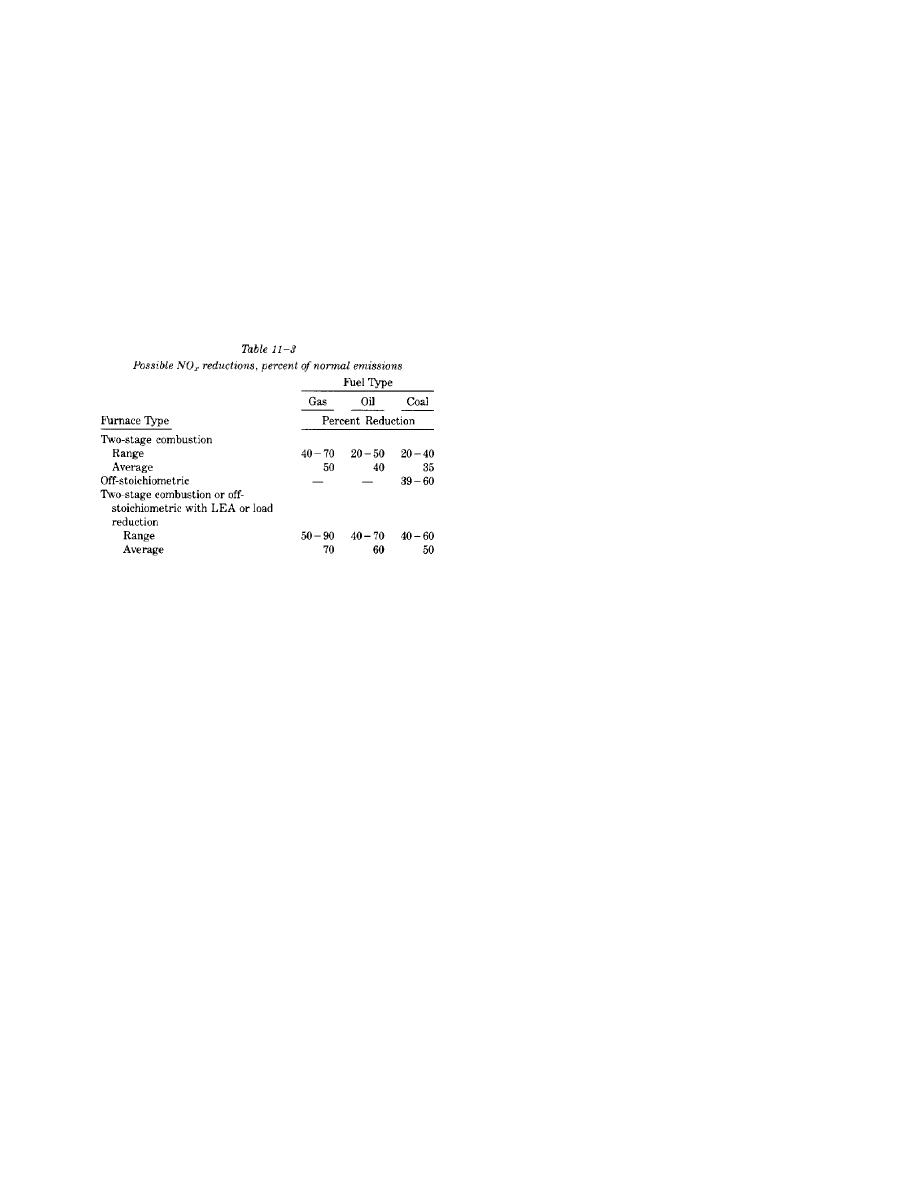
TM 5-815-1/AFR 19-6
combustion of all the fuel; and it reduces the
mixing accompanying the increased
amount of time the fuel and air mixture is
combustion air/ gas volume. Gas recirculation
exposed to higher temperatures.
does not significantly reduce plant thermal
(2) The application of some form of two stage
efficiency but it can influence boiler
combustion implemented with overall low
operation. Radiation heat transfer is reduced
excess air operation is presently the most
in the furnace because of lower gas
effective method of reducing NOx emissions
temperatures, and convective beat transfer is
increased because of greater gas flow.
this combustion modification technique in
(2) The extent of the applicability of this
utility boilers are listed in table 11-3.
modification remains to be investigated. The
However, it should be noted that this
quantity of gas necessary to achieve the
technique is not usually adaptable to small
desired effect in different installations is
industrial boilers where only one level of
important and can influence the feasibility of
burners is provided.
the application. Implementing flue-gas
recirculation means providing duct work and
recycle fans for diverting a portion of the
exhaust flue-gas back to the combustion air
windbox. It also requires enlarging the
windbox and adding control dampers and
instrumentation to automatically vary flue-gas
recirculation as required for operating
conditions and loads.
h. Steam or water injection. Steam and water injec-
tion has been used to decrease flame temperatures and
reduce NOx emissions. Water injection is preferred
over steam because of its greater ability to reduce tem-
perature. In gas and coal fired units equipped with
standby oil firing with steam atomization, the atomizer
offers a simple means for injection. Other installations
f. Reduced preheat temperature. NOx emissions are
require special equipment and a study to determine the
influenced by the effective peak temperature of the
proper point and degree of atomization. The use of
combustion process. Any modifications that lower
water or steam injection may entail some undesirable
peak temperature will lower NOx emissions. Lower air
operating conditions, such as decreased efficiency and
preheat temperature has been demonstrated to be a
increased corrosion. A NOx reduction rate of up to 10
factor in controlling NOx emissions. However, reduced
percent is possible before boiler efficiency is reduced
preheat temperature is not a practical approach to NOx
to uneconomic levels. If the use of water injection
reduction because air preheat can only be varied in a
requires installation of an injection pump and attendant
narrow range without upsetting the thermal balance of
piping, it is usually not a cost-effective means of
the boiler. Elimination of air preheat might be expected
reducing NOx emissions.
to increase particulate emissions when burning coal or
oil. Preheated air is also a necessary part of the coal
11-4.
Post combustion Systems for NOx
pulverizer operation on coal fired units. Jn view of he
reduction.
penalties of reduced boiler efficiency and other disad-
vantages, reduced preheat is not a preferred means of
a. Selective catalytic reduction (SCR) of NOx is
lowering NOx emissions.
based on the preference of ammonia to react with NO,
g. Flue-gas recirculation. This technique is used to
rather than with other flue-gas constitutents. Ammonia
lower primary combustion temperature by recirculating
is injected so that it will mix with flue-gas between the
part of the exhaust gases back into the boiler com-
economizer and the air heater. Reaction then occurs as
bustion air manifold. This dilution not only decreases
this mix passes through a catalyst bed. Problems
peak combustion flame temperatures but also
requiring resolution include impact of ammonia on
decreases the concentration of oxygen available for
downstream equipment, catalyst life, flue-gas
NOx formation. NOx reductions of 20 to 50 percent
monitoring, ammonia availability, and spent-catalyst
have been obtained on oil-fired utility boilers but as yet
disposal.
have not been demonstrated on coal-fired units. It is
b. Selective noncatalytic reduction (SNR) Ammonia
estimated that flue gas recirculation has a potential of
is injected into the flue-gas duct where the temperature
decreasing NOx emissions by 40 percent in coal-fired
favors the reaction of ammonia with NOx in the flue-
units.
gas. The narrow temperature band which favors the
(1) Flue gas recirculation has also produced a
reaction and the difficulty of controlling the tem-
reduction on CO concentrations from normal
perature are the main drawbacks of this method.
operation because of increased fuel-air
11-4


 Previous Page
Previous Page
